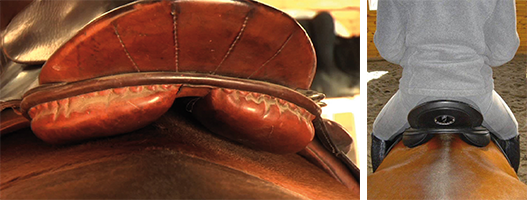Defensive behaviour? Not going on the bit? If the saddle puts pressure on the horse’s reflex points along the spine (if the gullet channel is too narrow) your horse will reflexively lower his back to escape the pressure and pain. Your goal of having the horse engage his back and raise it when he is ridden becomes unachievable. Forward impulse and momentum is lost. Your horse would like to respond to the aids, but the pressure on his reflex points inhibits his ability to do so.
Many riders believe if they use an extra thick saddle pad this will help the horse’s back when they notice pressure points or sensitivity along the horse’s spine. This ‘well-meaning’ does not necessarily end well. A saddle with a gullet that is too tight will only get tighter with extra padding (regardless of what the padding is made of). It’s like trying to fix a pair of shoes that are too tight and causing blisters by adding an extra pair of thick socks. It only makes the problem worse! The saddle must not sit on the vertebral processes, the dorsal ligament system (running along the horse’s back), or on the nerve ends that originate all along the spine. Your horse will only be able to move properly and freely in all gaits, lateral movements and over jumps if the gullet channel is optimal width to eliminate uncomfortable pressure caused by the saddle.

In order to prevent long-term damage the gullet channel needs to be wide enough for the horse’s spine and not impinge the movement. This is especially important for horses with wider spines such as – Arabs, Trakehners and other Baroque style breeds. The gullet channel should be wide enough through the entire length of the saddle to accommodate the spinal processes, ligaments and nerve endings from front to back. The wider the gullet channel, the smaller the panel – and less weight bearing surface for the saddle on the horse’s back. A somewhat-too-wide gullet channel is better than one that is too narrow. The optimum width of the gullet channel is between 2.5 to 4” (4-5 fingers). The more common occurrence is saddles with a too narrow gullet channel, or wide at the front and narrowing at the back of the saddle.
Saddle pads should be used only to protect the leather from the horse’s sweat. Pads can be used only temporarily to assist in proper fit. Even the best saddle pad in the world is never a substitute for regular saddle fit evaluation and adjustments that will ensure optimal saddle fit for your horse in motion.
Jochen Schleese is author of ‘Suffering in Silence – The Saddle fit Link to Physical and Psychological Trauma in Horses’ (2013). Through the Saddlefit 4 Life global network of equine professionals Jochen Schleese provides industry education to help equestrians recognize and prevent saddle fit issues and long term damage to horse and rider. Find answers in a personal 80 point Saddle Fit Evaluation to horse and rider.
www.SaddlesforWomen.comand Guys too! 1-800-225-2242 www.Saddlefit4life.com
http://www.youtube.com/embed/i95-bm_3U4s












